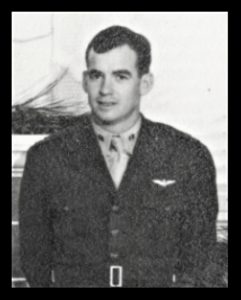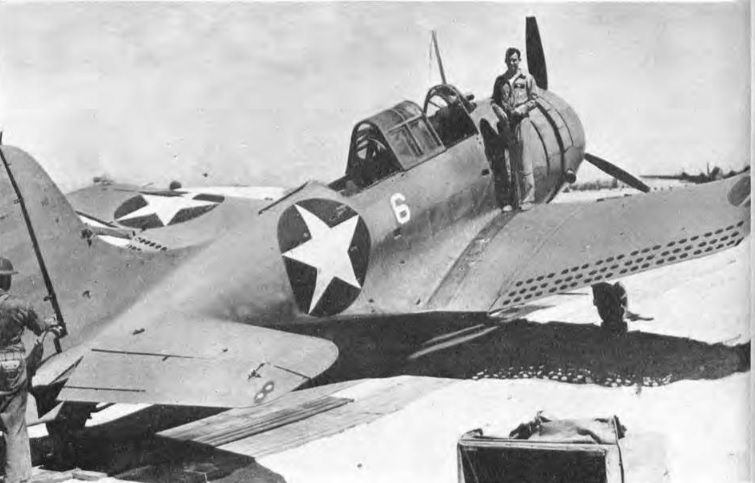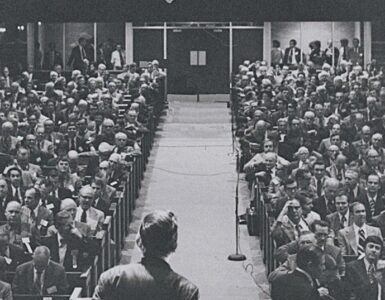 Shortly after the Japanese attacked Pearl Harbor, December 7, 1941, Marine 2nd. Lt. Daniel Iverson, Jr., was ordered from San Diego to Hawaii as the machinery of American militarization and manufacturing might were thrown into high gear to defeat Japan. Dan’s stay in Hawaii was brief because early in January he sailed aboard the sea-plane tender U.S.S. Thornton for Midway. Midway is a two-and-a-half square mile atoll located 1,300 miles northwest of Honolulu that provided an airfield and submarine base half-way between San Diego and Japan. It was crucial that Midway be defended successfully to protect Hawaii and prohibit invasion of the United States. As Dan looked out over the waves from the Thornton, little did he or any of his colleagues know what was in store for them on the postage-stamp island named Midway.
Shortly after the Japanese attacked Pearl Harbor, December 7, 1941, Marine 2nd. Lt. Daniel Iverson, Jr., was ordered from San Diego to Hawaii as the machinery of American militarization and manufacturing might were thrown into high gear to defeat Japan. Dan’s stay in Hawaii was brief because early in January he sailed aboard the sea-plane tender U.S.S. Thornton for Midway. Midway is a two-and-a-half square mile atoll located 1,300 miles northwest of Honolulu that provided an airfield and submarine base half-way between San Diego and Japan. It was crucial that Midway be defended successfully to protect Hawaii and prohibit invasion of the United States. As Dan looked out over the waves from the Thornton, little did he or any of his colleagues know what was in store for them on the postage-stamp island named Midway.
Dan’s background was no more unusual than many of the individuals that joined the war effort. He was born in Columbia, South Carolina, November 11, 1916, the son of Daniel and Vivian Fraser (Thorpe) Iverson. His mother was from Savannah and would come to enjoy a long life passing away at 103; his father had recently been installed pastor of St. Matthews Presbyterian Church after supplying its pulpit during his Columbia Seminary studies. He left St. Matthews in 1919, then after two brief calls in North Carolina, the Iversons moved to Miami, Florida, 1926. Dan’s father was the organizing pastor of Shenandoah Presbyterian Church which grew to include numerous families in the congregation that provided many young people for Dan to befriend with his engaging smile. He graduated Miami High School in 1934. Davidson College was the next step for him, and when it was time for his senior photograph for the yearbook in 1938, the staff instead included a picture of him smiling as he casually descended some wooden stairs. The yearbook editors’ caption noted that Dan “quipped with the professors,” “held down a forward position on the basketball team”, and “added a clowning touch” on campus. He returned to Miami to work for Equitable Life Insurance Company but then enlisted to become a Marine pilot in November 1939. Two months earlier Hitler had launched his blitzkrieg of Poland resulting in its occupation, so possibly Dan signed up for service realizing his country was headed for war. He was trained to fly in Pensacola and was given his wings in October 1940.
Once Dan arrived at Midway, he settled in to a pilot’s life logging hours in the air and fulfilling other duties while waiting for something to happen, and it did. Early in May the Battle of the Coral Sea had taken place, after which the Japanese moved their forces to attack Midway. Included in the massive fleet were four heavy aircraft carriers. It was the second day of battle, June 4, as events unfolded, Iverson and his gunner Private First-Class Wallace Reed climbed aboard their SBD-2 [Scout Bomber Douglas-2] Dauntless dive bomber and joined fifteen other planes to engage the enemy. Iverson selected his target which he described as having “two rising suns on the flight deck—fore and aft” indicating the carrier was the Hiryu (Miami News, 7/29/42). He pushed the stick fully forward beginning his steep plunging through heavy anticraft fire while pursued by two Japanese Zeros. At an altitude of 800 feet he released his bomb, but it fell just to the side of the carrier. Pulling out of the dive the two Zeros were still in tow firing at the SBD-2 until Iverson was able to lose them in the clouds. It is remarkable that he and his colleague survived. The Marines did not sink the Hiryu but despite what appears to have been a pointless attack by the Marine flyers, they had caught the enemy by surprise creating confusion that contributed to a break in formation and challenges for the Japanese command. Returning to base were only eight of the sixteen planes that engaged the enemy; five of the planes required considerable repair work. Iverson had to cautiously land his plane on one wheel, with a damaged wing, and without hydraulic controls because the system had been damaged by enemy fire.
When the weary duo climbed out of the plane Reid surveyed their SBD-2 counting 219 hits from bullets, but only one of the bullets concerned Iverson, the one that passed close enough to cut the cable to his throat microphone. He was awarded the Navy Cross and Reid was given the Distinguished Flying Cross. When the Battle of Midway ended on June 6, it had been primarily a naval conflict that inflicted considerable damage against the Japanese forces with four carriers, a heavy cruiser, and more than 320 aircraft destroyed while the United States suffered the loss of a carrier, destroyer, and 150 aircraft. The victory at Midway severely affected Japan’s ability to wage war and is considered the turning point for the Pacific theater of World War 2. Young Iverson now had battle experience under his belt and would go on from Midway to other assignments.
Following the crucial success at Midway there were more engagements for Iverson and his fellow Marines as they fought Japan’s efforts to extend its empire in the Pacific. On July 6, 1942, the Japanese moved troops and construction workers to Guadalcanal to build an airstrip in the southern Solomon Islands. It was a strategic location offering Japanese aircraft access to New Guinea and the New Hebrides (Vanuatu). The United States could not let the Japanese occupy Guadalcanal, so on August 7, 1942, the 1st Marine Division with naval and air support that included Dan Iverson caught the Japanese by surprise facilitating quick occupation of the island and control of the airstrip. Summarized in The Miami News, September 6, 1942, is a letter Iverson sent to his family including his youngest brother William, nicknamed by Dan, “Wild Bill.” Dan’s jokester personality was clearly intact despite the difficulties of war. He told the family he was doing well at Guadalcanal and still fighting. Food was no problem because the “Japs left plenty of provisions for us. A lot of what we eat is Japanese food.” Iverson added that the Japanese on Guadalcanal were eating breakfast and were thoroughly surprised when the Marines arrived. He included in the envelope with the letter some Japanese currency and promised to take home a blanket from the booty to cover a bed in the Iversons’ guest room. His mother may have become worried when he said, “I smell like a billy goat. I haven’t had a bath since we landed. However, I do carry a toothbrush in my pocket.” The article closed with “Well, I hope some day to arrive home, well and strong and still smiling.”
Dan’s opportunity to go home came in October. He was wounded while fighting at Guadalcanal. His condition led to time in a hospital in California. When discharged, he drove to Miami arriving there November 28 with 87 days of leave to recover. He was a local hero in the city and was invited to speak to the Greater Miami Airport Association, the Coral Gables Optimist Club, and to the Miami Woman’s Club. With his leave about to run out on February 10, 1943, Dan and Margaret Hough (Fisher) of Philadelphia married. Margaret’s father was a vice president for Westinghouse Corporation which contributed production to the war effort. Daniel Iverson presided over the wedding service with Dan’s sister Vivian a bridesmaid and Wild Bill the best man. Counting out the days of his leave it works out that the newlyweds had two weeks of honeymoon as they drove to San Diego for his next duty.
The reason for his injuries is seen in the citation for the silver star he received in June 1943 for service at Guadalcanal. Dan was honored for,
conspicuous gallantry and intrepidity in the action against enemy Japanese forces while serving with marine scout bombing squadron 232 on Guadalcanal in August and September, 1942. Shortly after midnight on Aug. 25, Captain Iverson, a member of a three-plane section, took off from his base and successfully located and attacked one enemy light cruiser and four destroyers which had been shelling our camp area.
In spite of poor visibility and fierce anti-aircraft fire, Captain Iverson and his unit followed [the bombing run] with a strafing attack, inflicting further damage on the enemy. Three days later, vigorously pressing forward the attack, Captain Iverson assisted in sinking three out of four enemy destroyers.
Again on Sept. 7 and 8 during landing operations by our raiders, he made several reconnaissance flights and flying low in the face of determined enemy fire, led sections of our forces in bombing attacks supporting ground troops. By his expert airmanship and valiant initiative, he rendered invaluable service to the ground organization. (The Miami News 6/6/43)
Notice that three SBDs took on a light cruiser and four destroyers.
What had started as a quick action at Guadalcanal had become by August 9 a heavy and costly campaign for the United States. Iverson participated gallantly in several actions and by the end of August was promoted to Captain. The almost to the day six-month Guadalcanal campaign ebbed and flowed in intensity, but for Iverson and the flyers the great challenge was destroying Japanese naval and support vessels while dodging bullets at the airstrip and in the air. Guadalcanal ended February 9, 1943 when the United States massive army gathered during the previous months forced the last pocket of Japanese resistance to leave. Guadalcanal was decisive and solidified American positions in the southern Solomon Islands while providing a strong base of operations and defensive location for the region. The campaign resulted in 24,000 Japanese dead, while 1600 Americans were killed, with 4200 wounded, and several thousand others were afflicted with malaria and other tropical diseases. Among the 24 ships lost by each side the greatest loss for the United States was the 8 cruisers and 2 heavy carriers sunk by the enemy while Japan lost only one light carrier. The price of victory was great for the United States, but the taking of Guadalcanal was essential and success confirmed the war had turned in favor of the Allies.
Sunday, January 23, 1944, subscribers to The Miami Herald surveyed the skies before bending over to pick up their morning papers from the lawn, flipping them open to see front page center, “Major Iverson Dies in Crash at Vero Beach: Daring Miami Flier Killed in Mid-Air.” After all the bullets, shell fragments, and dangers faced by Dan in battle, he was killed Saturday in an accident off the coast near Vero Beach. Dan was instructor in operational dive bombing and had been a Major since June. It was a difficult Lord’s Day for the Iversons having received the news. Daniel Iverson informed the Herald that he had just received a letter from Dan informing the family he had orders to report to the West Coast, “He thought it meant a return to combat duty and was happy.” He had been flying near the air station of the United States Naval Training Base at Vero Beach when a student pilot flying a plane below him decided to climb. Apparently he did not look before pulling the stick back and flew into the bottom of Iverson’s plane resulting in an explosion. Dan would smile no longer in this life. He was survived by his wife Margaret and their six-week old daughter, his dad and mom, brothers Bill and Ned (a Navy chaplain), and sisters Vivian, Lalla, and a third sister. Maj. Iverson is interred in Piney Grove Cemetery, Swannanoa, North Carolina. The Iversons were another family saddened by the tragedy of war as Danny was added to what would become by the end of the war over 400,000 military personnel killed including 24,000 United States Marines.
When Jesus was asked in Matthew 24 what will be the signs of the end of the world, included in his answer was, “You will hear of wars and rumors of wars” (vs. 6). This prophecy has been confirmed in abundance for two millennia while the Church has followed His instruction that “this gospel of the kingdom will be proclaimed throughout the whole world” (vs. 14). Major Iverson fought and died for his country, but more importantly he died in Christ having been blessed with a covenant home. It would be wonderful if all wars would end and it is good to work judiciously and not naïvely to achieve the end of wars, but war will ultimately end through fulfillment of the Kingdom of God and membership in that kingdom comes only through Christ.
Barry Waugh
Notes—Dan was used for Daniel, Jr., and Daniel was used for Sr. to avoid confusion, but it appears Jr. used both Dan and Danny. Hill Goodspeed of the National Naval Aviation Museum in Pensacola tells the history of Iverson’s SBD-2 Dauntless from deployment through its restoration completed in 2001 as he stands before the airplane in the video, “History Up Close With the SBD Dauntless BuNo 2106,” at https://www.youtube.com/watch?v=mAfxvUqmNqk. The header image showing Iverson’s dive bomber with its 219 hits is from Marines at Midway, 1948 (public domain); the man standing on the wing appears to be Dan. About the finding and restoration of Iverson’s aircraft see the interesting story by Michael Browning on The Seattle Times website, “Midway Warplane Being Restored—Dive Bomber Called The Last U.S. Aircraft From ’42 Battle”; also, the article “H-006-6: SBD-2 Dauntless, BuNo 2106, Battle of Midway Veteran,” on the Naval History and Command website provides a full history of the plane which the author, Hill Goodspeed, believes “is one of the most historic aircraft in existence anywhere in the world.” The Davidson College yearbook is titled Quips and Cranks and is available on Internet Archive. It appears to me that the movie Midway, 1976, starring Heston, Fonda, Mitchum, Wagner, et al, possibly shows Dan’s plane diving towards a carrier with his bomb dropping and exploding; a good movie. One of my favorite flicks is PT 109 starring Cliff Robertson playing future president Kennedy; the setting of the events is the Solomon Islands, but it was filmed in the Florida Keys. Rendova, mentioned in PT 109, is about 200 miles west-northwest of Guadalcanal. For information about Dan’s father see, “South Florida Presbytery, 50th Anniversary of PCA,” on this site. A helpful resource for information is, War Casualties from World War II for Navy, Marine Corps, and Coast Guard Personnel, 1946. Battle records of ships at Pearl Harbor are available from the Naval History and Heritage Command. For personal information about the Iverson family including three photographs see, “Bill Iverson Tribute to My Father,” the link will take you directly to a PDF download. In addition to the issues of the Miami News (Miami Daily News), and The Miami Herald cited in the article, about 60 other issues were referred to for information. Pilots might enjoy reading the article “SBD Dauntless Dive Bomber – A Pilot’s Perspective,” which I found helpful regarding the diving technique, and the brief but informative video “The Terrifying Physics of WWII Dive Bombing,” at https://www.youtube.com/watch?v=dsZWPELYtAI explains dive and torpedo bombing using CG and historic film for a virtual experience with the help of expert commentators. The University of Kentucky has maps of the Pacific war available at: https://uknowledge.uky.edu/cgi/viewcontent.cgi?article=1395&context=kaleidoscope.





